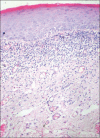Oral lichenoid lesions - a review and update
- PMID: 25657414
- PMCID: PMC4318020
- DOI: 10.4103/0019-5154.147830
Oral lichenoid lesions - a review and update
Abstract
Background: Oral lichenoid lesions or reactions (OLLs/OLRs) are clinical and histological contemporaries of the classical oral lichen planus (OLP) that have generated a lot of debate in literature. In contrast to the idiopathic nature of OLP, OLLs are often associated with a known identifiable inciting factor. A superficial examination of these lesions clinically and histologically often reveals many similarities with OLP, but recent data indicate that distinguishable features do exist and form the basis of most classifications.
Aims and objectives: This paper attempts to collate available data in English literature on OLLs, highlight distinguishing features clinically and histologically and reflect on the malignant transformation potential and treatment modalities of the condition.
Materials and methods: A comprehensive search of medical and dental databases including PubMed, Ovid, Cochrane, Pubget, Researchgate, and non-medical search engines were utilized for the review. The search words included "oral lichen planus", "oral lichenoid lesions", "oral drug reactions", "lichenoid dysplasia", and "adverse effects of dental materials".
Review results: OLLs seem to grossly underrated and most cases were clubbed as OLP. Definite clinical and histological features were uncovered to establish the identity of this lesion. Associations with dental restorative materials, drugs, and medications have been conclusively proven in the etiology of this condition. Specific markers are being utilized to diagnose the condition and monitor its progress.
Conclusion: Substantial differentiating features were uncovered to delineate OLLs as a separate entity with definite etiology, pathogenesis, and a high malignant transformation rate compared with OLP.
Keywords: Drug association; literature review.malignant transformation; oral lichen planus; oral lichenoid lesions; oral lichenoid reactions.
Conflict of interest statement
Figures






Similar articles
-
Comparative Analyses of Clinical Features, Histopathology, and CD123 Immunohistochemistry of Oral Lupus Erythematosus, Lichen Planus, and Other Lichenoid Lesions.Dermatology. 2022;238(3):464-475. doi: 10.1159/000517971. Epub 2021 Aug 11. Dermatology. 2022. PMID: 34515092
-
A Rare Case of Hair Dye Induced Oral Lichenoid Reaction.Int Med Case Rep J. 2023 Jun 6;16:345-350. doi: 10.2147/IMCRJ.S410639. eCollection 2023. Int Med Case Rep J. 2023. PMID: 37303473 Free PMC article.
-
Lichenoid dysplasia revisited - evidence from a review of Indian archives.J Oral Pathol Med. 2015 Aug;44(7):507-14. doi: 10.1111/jop.12258. Epub 2014 Sep 15. J Oral Pathol Med. 2015. PMID: 25224597
-
Oral lichenoid lesions in HIV-HCV-coinfected subjects during antiviral therapy: 2 cases and review of the literature.Am J Dermatopathol. 2008 Oct;30(5):466-71. doi: 10.1097/DAD.0b013e31817e23af. Am J Dermatopathol. 2008. PMID: 18806491 Review.
-
Malignant transformation risk of oral lichen planus: A systematic review and comprehensive meta-analysis.Oral Oncol. 2019 Sep;96:121-130. doi: 10.1016/j.oraloncology.2019.07.012. Epub 2019 Jul 22. Oral Oncol. 2019. PMID: 31422203
Cited by
-
Clinical and biochemical assessment of the effect of topical use of coenzyme Q10 versus topical corticosteroid in management of symptomatic oral lichen planus: randomized controlled clinical trial.BMC Oral Health. 2023 Jul 21;23(1):506. doi: 10.1186/s12903-023-03206-5. BMC Oral Health. 2023. PMID: 37480004 Free PMC article. Clinical Trial.
-
Is Aneuploidy a Consistent Marker for Malignant Transformation Risk in Oral Lichen Planus?Head Neck Pathol. 2025 May 8;19(1):54. doi: 10.1007/s12105-025-01779-x. Head Neck Pathol. 2025. PMID: 40338413 Free PMC article.
-
Differential genotypes of TNF-α and IL-10 for immunological diagnosis in discoid lupus erythematosus and oral lichen planus: A narrative review.Front Immunol. 2022 Aug 5;13:967281. doi: 10.3389/fimmu.2022.967281. eCollection 2022. Front Immunol. 2022. PMID: 35990645 Free PMC article. Review.
-
Oral lichenoid lesions of the upper lip.J Dermatol Case Rep. 2017 Mar 31;11(1):16-19. doi: 10.3315/jdcr.2017.1243. eCollection 2017 Mar 31. J Dermatol Case Rep. 2017. PMID: 28539985 Free PMC article.
-
Carbamazepine-Induced Oral Lichenoid Reaction: A Report of a Rare Case.Cureus. 2025 Apr 7;17(4):e81835. doi: 10.7759/cureus.81835. eCollection 2025 Apr. Cureus. 2025. PMID: 40337574 Free PMC article.
References
-
- Almeyda J, Levantine A. Drug reactions. XVI. Lichenoid drug eruptions. Br J Dermatol. 1971;85:604–7. - PubMed
-
- Penneys NS, Ackerman AB, Gottlieb NL. Gold dermatitis. A clinical and histopathological study. Arch Dermatol. 1974;109:372–6. - PubMed
-
- Cortés-Ramírez DA, Rodríguez-Tojo MJ, Gainza-Cirauqui ML, Martínez-Conde R, Aguirre-Urizar JM. Overexpression of cylcooxygenase-2 as a biomarker in different subtypes of the oral lichenoid disease. Oral Surg Oral Med Oral Pathol Oral Radiol Endod. 2010;110:738–43. - PubMed
-
- Wataha JC, Malcolm CT, Hanks CT. Correlation between cytotoxicity and the elements released by dental casting alloys. Int J Prosthodont. 1995;8:9–14. - PubMed
-
- Marek M. Interactions between dental amalgams and the oral environment. Adv Dent Res. 1992;6:100–9. - PubMed
Publication types
LinkOut - more resources
Full Text Sources
Other Literature Sources
